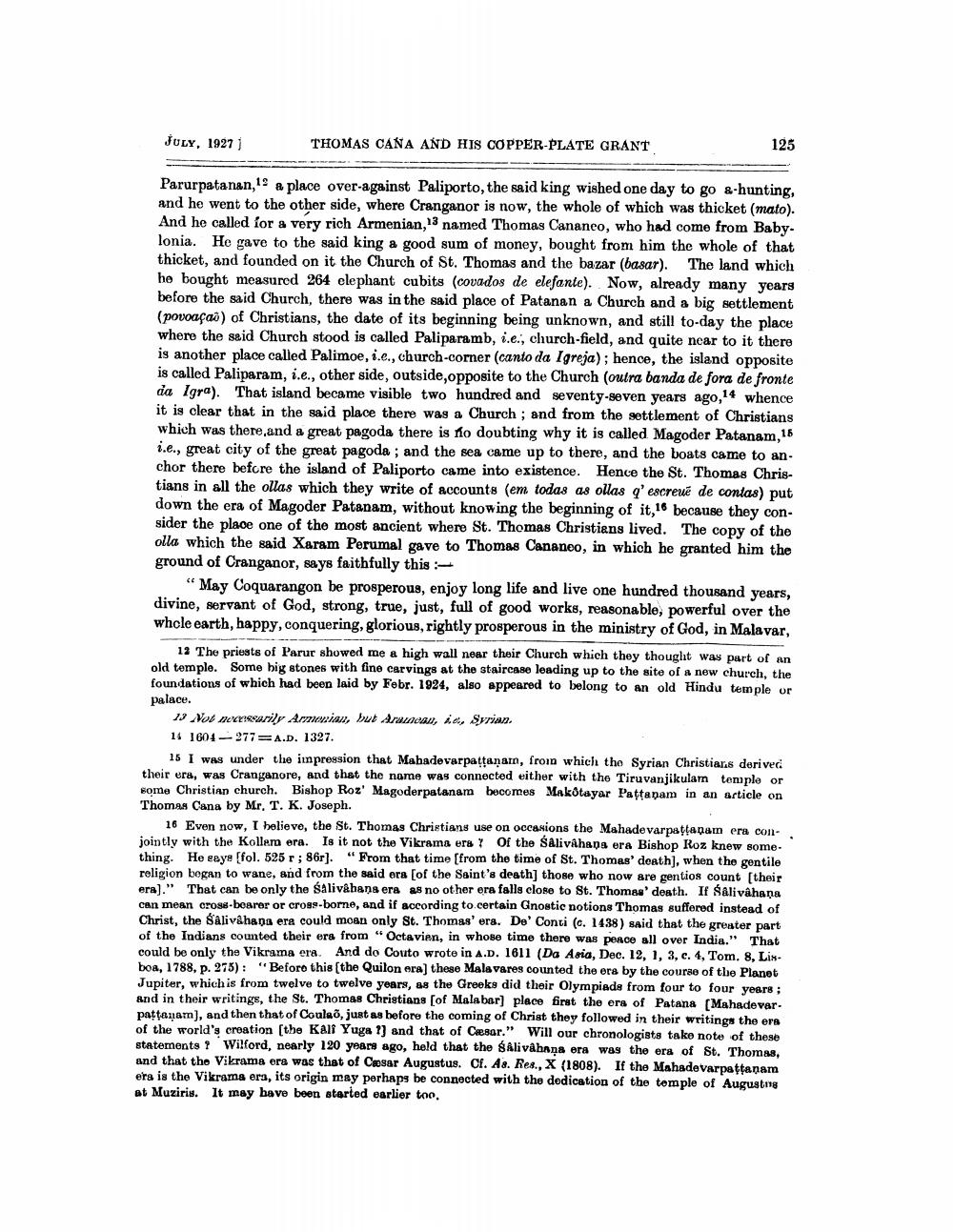________________
JULY, 1927)
THOMAS CANA AND HIS COPPER-PLATE GRANT
125
Parurpatanan, 12 a place over-against Paliporto, the said king wished one day to go & hunting, and he went to the other side, where Cranganor is now, the whole of which was thicket (mato). And he called for a very rich Armenian, 13 named Thomas Cananco, who had come from Babylonia. He gave to the said king a good sum of money, bought from him the whole of that thicket, and founded on it the Church of St. Thomas and the bazar (basar). The land which he bought measured 264 elephant cubits (covados de elefante). Now, already many years before the said Church, there was in the said place of Patanan a Church and a big settlement (povoaçao) of Christians, the date of its beginning being unknown, and still to-day the place where the said Church stood is called Paliparamb, i.e., church-field, and quite near to it there is another place called Palimoe, i.e., church-corner (canto da Igreja); hence, the island opposite is called Paliparam, i.e., other side, outside,opposite to the Church (outra banda de fora de fronte da Igra). That island became visible two hundred and seventy-seven years ago, whence it is clear that in the said place there was a Church, and from the settlement of Christians which was there and a great pagoda there is no doubting why it is called Magoder Patanam,15 i.e., great city of the great pagoda ; and the sea came up to there, and the boats came to anchor there before the island of Paliporto came into existence. Hence the St. Thomas Christians in all the ollas which they write of accounts (em todas as ollas q' escreue de contas) put down the era of Magoder Patanam, without knowing the beginning of it,16 because they consider the place one of the most ancient where St. Thomas Christians lived. The copy of the olla which the said Xaram Perumal gave to Thomas Cananeo, in which he granted him the ground of Cranganor, says faithfully this
"May Coquarangon be prosperous, enjoy long life and live one hundred thousand years, divine, servant of God, strong, true, just, full of good works, reasonable, powerful over the whole earth, happy, conquering, glorious, rightly prosperous in the ministry of God, in Malavar,
12 The priests of Parur showed me a high wall near their Church which they thought was part of an old temple. Some big stones with fine carvings at the staircase leading up to the site of a new church, the foundations of which had been laid by Febr. 1924, also appeared to belong to an old Hindu temple or palace.
1 Not necessarily Armenian, but Aru , ia, Syrian 14 1604 - 277= A.D. 1327.
15 I was under the impression that Mabadevarpattanam, from which the Syrian Christians derived their ura, was Cranganore, and that the name was connected either with the Tiruvanjikulam temple or some Christian church. Bishop Roz' Magoderpatanam becomes Makotayar Pattanam in an article on Thomas Cana by Mr, T. K. Joseph.
16 Even now, I believe, the St. Thomas Christians use on occasions the Mahadevarpattanam era con jointly with the Kollem era. Is it not the Vikrama ers Y Of the Salivahans era Bishop Roz knew some. thing. Ho eeye [fol. 525 r ; 86r). "From that time (from the time of St. Thomas' death), when the gentile religion began to wane, and from the said era [of the Saint's death] those who now are gentios count [their era)." That can be only the salivabans era as no other era falls close to St. Thomas' death. If Salivahana can mean cross-bearer or cross-borne, and if according to certain Gnostic notions Thomas suffered instead of Christ, the Šalivahana era could moan only St. Thomas' era. De' Conti (c. 1438) said that the greater part of the Indians counted their ers from "Octavian, in whose time there was ponce all over India." That could be only the Vikrama era. And do Couto wrote in A.D. 1611 (Da Asia, Dec. 12, 1, 3, c. 1, Tom. 8, Linboa, 1788, p. 275): "Before this (the Quilon era) these Malavares counted the ers by the course of the Planet Jupiter, which is from twelve to twelve years, as the Greeks did their Olympiads from four to four years ; and in their writings, the St. Thomas Christians [of Malabar) place first the era of Patana (Mahadevarpattanarn), and then that of Coulso, just as before the coming of Christ they followed in their writing the era of the world's creation (the Kali Yuga 1) and that of Cæsar." Will our chronologists take note of these statements ? Wilford, nearly 120 years ago, held that the Alivâhaņa era was the era of St. Thomas, and that the Vikrama era was that of Caesar Augustus. Cf. As. Res., X (1808). If the Mahadevarpattanam era is the Vikrams era, its origin may perhaps be connected with the dedication of the tomple of Augustng at Muziris. It may have been started earlier too.




